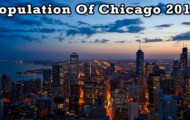New Orleans is an important United States port and also it is the largest city of Louisiana. The city is known for its specific French and Spanish Creole structures and its multifaceted and multilingual legacy. The city is in like way prominent for its cooking, music and its yearly festivals and events. The city is also well known for its distinctive attractions.
New Orleans was initially settled on the waterway’s characteristic levees or high ground. After the Flood Control Act of 1965, the US Army Corps of Engineers fabricated floodwalls and man-made levees around a considerably bigger geographic impression that included past marshland and bog.

The core of the city and its French Quarter is on the stream’s north side. The city is likewise a noteworthy center for voyagers and consistently individuals from all parts of the United States visit here for its remarkable way of life and also for its unique types of attractions within the city.
POPULATION OF NEW ORLEANS IN 2019:
To find out the correct numbers in terms of the population of New Orleans in 2019, we have to get the population data of the last 5 years. They are as per the following:
- 2014 –384,320
- 2015 –389,617
- 2016 – 398,775
- 2017 – 407,940
- 2018 - 417,100
We go through the population numbers of New Orleans from 2014-18 and from data you can see the numbers have gone up by 32,780 in the last 5 years. Therefore, every year it has been seen that the population increases by 6556. By this, the population of New Orleans in the year 2019 is predicted to be 417,100 + 6556 = 423,656. Hence, the population of New Orleans in 2019 as per estimated figures = 423,656.
New Orleans Population 2019 - 423,656 Million (estimated)
DEMOGRAPHY OF NEW ORLEANS:
According to the 2010 Census, 343,829 people and 189,896 families were in New Orleans. The racial and ethnic blend was 60% African American, 31% White, 5% Asian and 1.7% were of no less than two races. Those of Latino origin consisted of about 5.3% of the population in the city.
POPULATION DENSITY AND GROWTH OF NEW ORLEANS:
The population density of New Orleans is 858 persons per square kilometer. In 2012, 24/7 Wall St., perceived the 10 biggest urban zones with the quickest growing population in the nation in context of Census Bureau information. It is situated #1, with 4.9% development from 2010 to 2011. This is around 6 times the national average, yet New Orleans stays at 80% pre-Katrina levels. Fortunately the city is on the rising, eight years after Hurricane Katrina. As of late, the population has begun to grow and the city recuperated every last one of the occupations it lost in the start of 2012 with new development in information based associations.
If things go in a similar way, the city should experience no problems advancing back to what it was before the Hurricane Katrina and go beyond before the appraisal in the year 2020.
FACTS ABOUT NEW ORLEANS:
-
It is home to the longest tireless bridge in the globe.
-
Betting enthusiasts need to comprehend that New Orleans is generally thought to be the starting of poker.
-
The city was developed in 1718 by Jean Baptiste Le Moyne, Sieur de Bienville. First and foremost the community was fundamentally an exchanging camp on the east bank of the Mississippi
-
Around the start of the nineteenth century, the city and all the encompassing locales were sold to Napoleon Bonaparte amidst what was called as the Louisiana.
-
As per the National Register, the city has no less than 20 huge areas.



